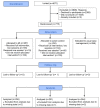Effectiveness of 'motivational interviewing' on sick leave: a randomized controlled trial in a social insurance setting
- PMID: 37634251
- PMCID: PMC10834143
- DOI: 10.5271/sjweh.4117
Effectiveness of 'motivational interviewing' on sick leave: a randomized controlled trial in a social insurance setting
Abstract
Objective: This study aimed to evaluate the effectiveness of motivational interviewing (MI) - a counselling approach offered by caseworkers at the Norwegian Labor and Welfare Administration (NAV) - on return to work (RTW) for individuals sick-listed for ≥8 weeks due to any diagnoses. MI was compared to usual case management and an active control during 12 months of follow-up.
Methods: In a randomized clinical trial with three parallel arms, participants were randomized to MI (N=257), usual case management (N=266), or an active control group (N=252). MI consisted of two MI sessions while the active control involved two sessions without MI, both were offered in addition to usual case management. The primary outcome was number of sickness absence days based on registry data. Secondary outcomes included time to sustainable RTW, defined as four consecutive weeks without medical benefits.
Results: The median number of sickness absence days for the MI group was 73 days [interquartile range (IQR) 31-147], 76 days (35-134) for usual care, and 75 days (34-155) for active control. In total 89%, 88% and 86% of the participants, respectively, achieved sustainable RTW. The adjusted hazard ratio (HR) for time to sustainable RTW was 1.12 (95% CI 0.90-1.40) for MI compared to usual case management and HR 1.16 (95% CI 0.93-1.44) compared to the active control.
Conclusions: This study did not provide evidence that MI offered by NAV caseworkers to sick-listed individuals was more effective on RTW than usual case management or an active control. Providing MI in this context could be challenging as only half of the MI group received the intervention.
Conflict of interest statement
The authors declare no conflicts of interest.
Figures



Similar articles
-
Study protocol for a randomized controlled trial of the effectiveness of adding motivational interviewing or stratified vocational advice intervention to usual case management on return to work for people with musculoskeletal disorders. The MI-NAV study.BMC Musculoskelet Disord. 2020 Jul 28;21(1):496. doi: 10.1186/s12891-020-03475-z. BMC Musculoskelet Disord. 2020. PMID: 32723318 Free PMC article.
-
Motivational interviewing in long-term sickness absence: study protocol of a randomized controlled trial followed by qualitative and economic studies.BMC Public Health. 2018 Jun 18;18(1):756. doi: 10.1186/s12889-018-5686-0. BMC Public Health. 2018. PMID: 29914463 Free PMC article. Clinical Trial.
-
Sick-listed workers' experiences with motivational interviewing in the return to work process: a qualitative interview study.BMC Public Health. 2020 Feb 28;20(1):276. doi: 10.1186/s12889-020-8382-9. BMC Public Health. 2020. PMID: 32111199 Free PMC article. Clinical Trial.
-
Evidence-informed decision about (de-)implementing return-to-work coordination to reduce sick leave: a case study.Health Res Policy Syst. 2022 Feb 14;20(1):19. doi: 10.1186/s12961-022-00823-4. Health Res Policy Syst. 2022. PMID: 35164766 Free PMC article. Review.
-
Non-medical interventions to enhance return to work for people with cancer.Cochrane Database Syst Rev. 2024 Mar 5;3(3):CD007569. doi: 10.1002/14651858.CD007569.pub4. Cochrane Database Syst Rev. 2024. PMID: 38441440 Free PMC article.
Cited by
-
Getting an outsider's perspective - sick-listed workers' experiences with early follow-up sessions in the return to work process: a qualitative interview study.BMC Health Serv Res. 2024 May 9;24(1):609. doi: 10.1186/s12913-024-11007-x. BMC Health Serv Res. 2024. PMID: 38724997 Free PMC article.
References
-
- OECD. Sickness, Disability and Work: Breaking the Barriers. OECD Publishing; 2010.
-
- Loisel P, Durand MJ, Berthelette D, Vezina N, Baril R, Gagnon Det al. . Disability Prevention: New Paradigm for the Management of Occupational Back Pain. Dis Manag Health Outcomes 2001;9:351–60. 10.2165/00115677-200109070-00001 - DOI

